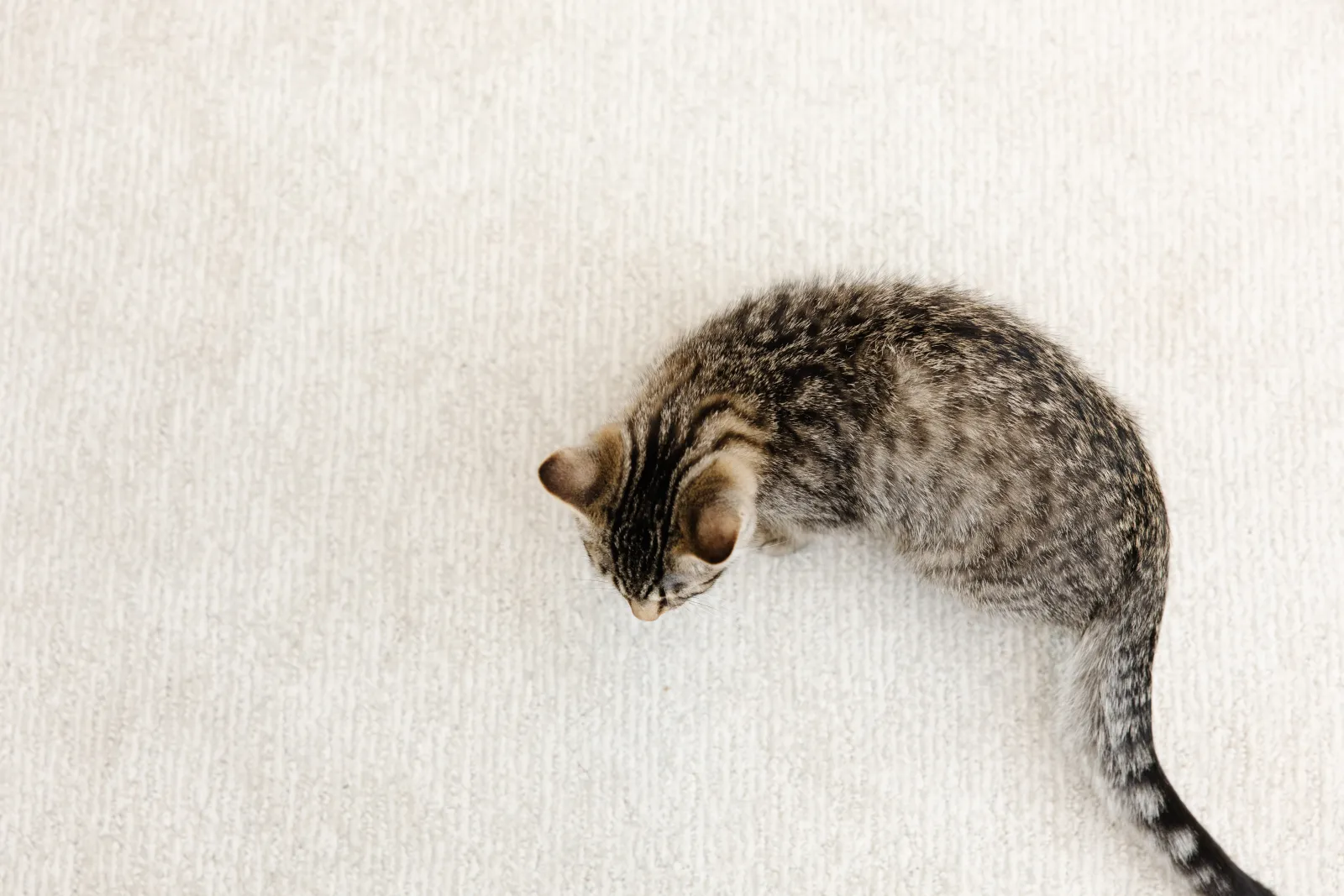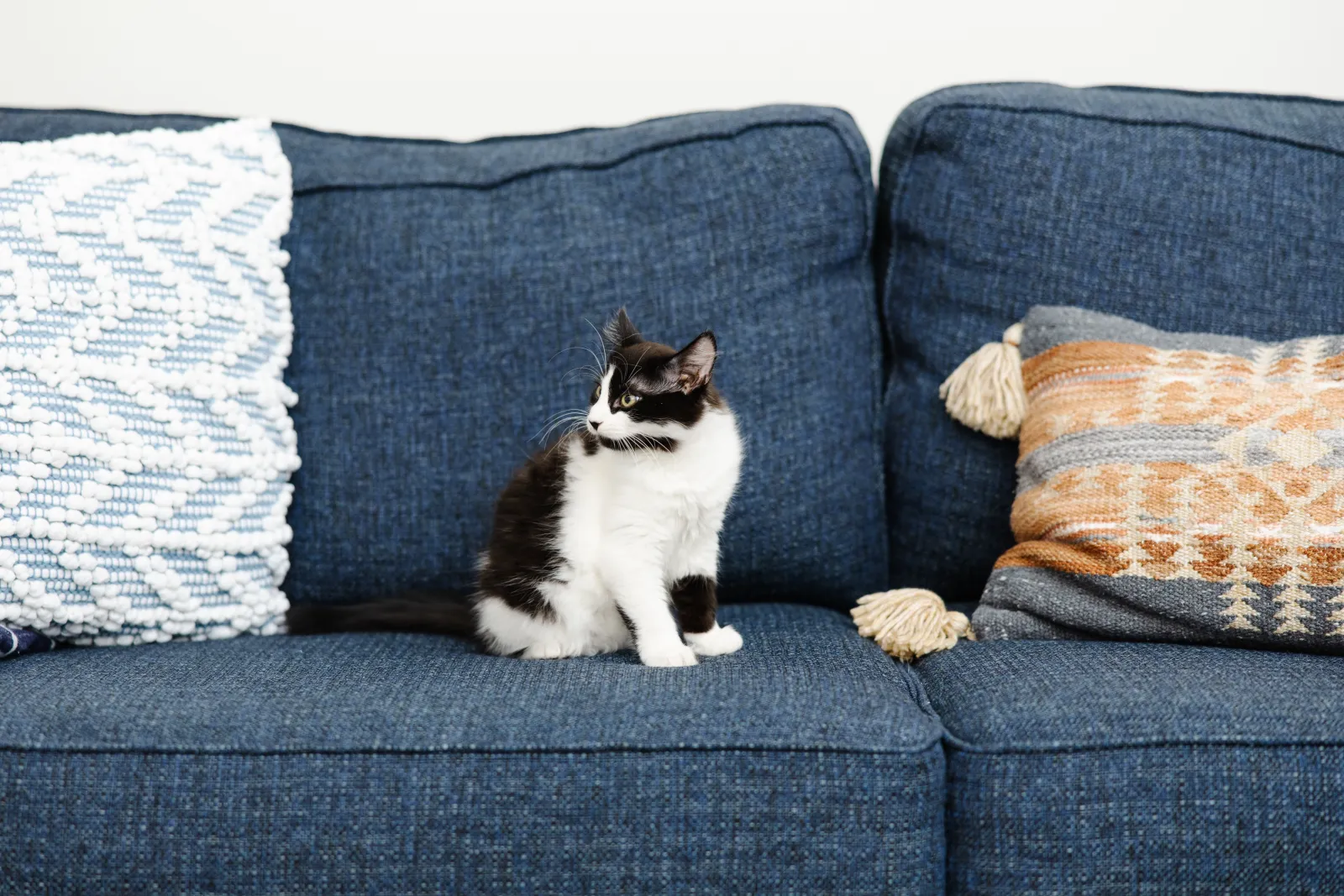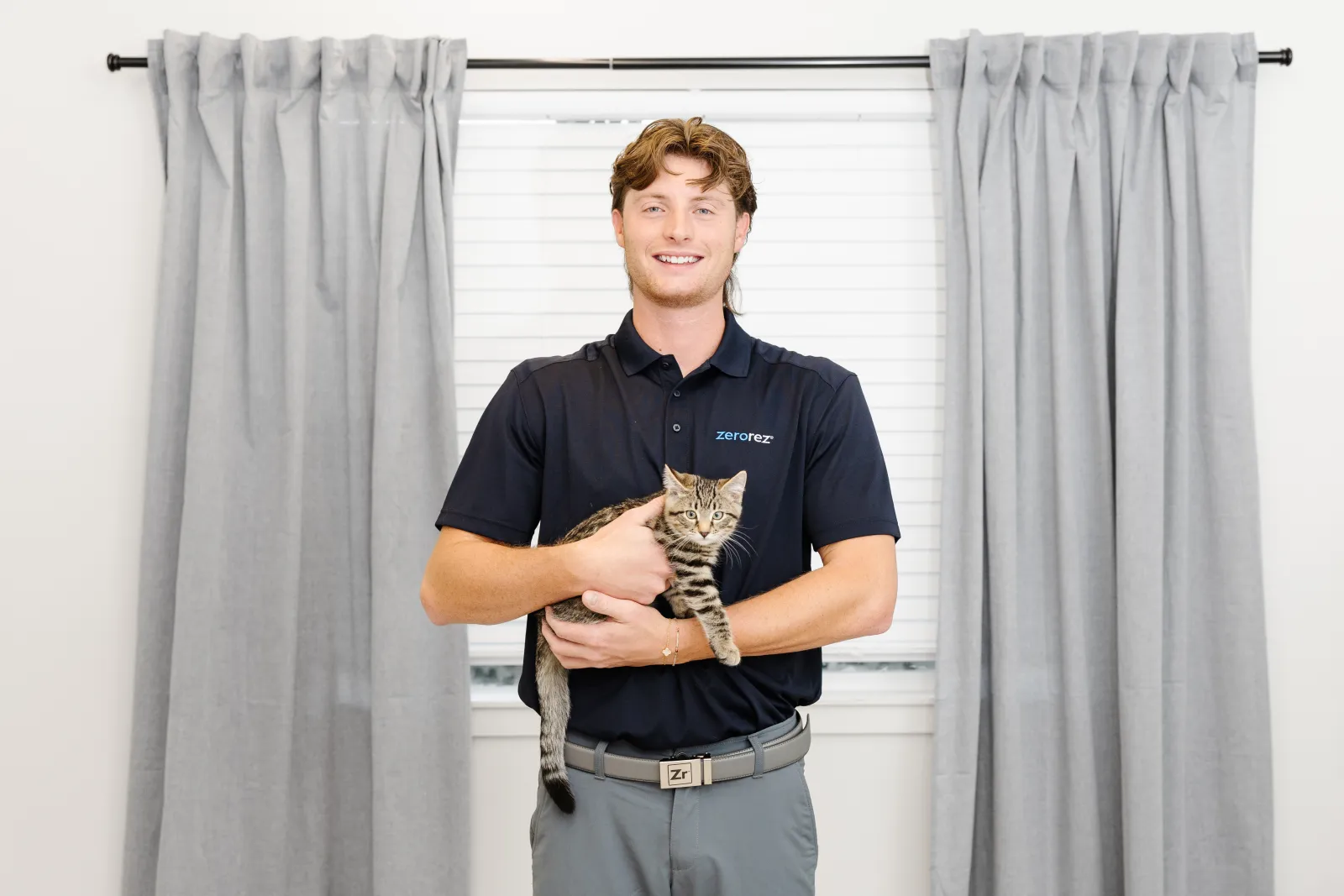How To Keep Cats From Clawing Your Carpet
Carpet clawing is essential for a cat's physical and mental health, but watching your carpets being damaged is frustrating. So how do you keep your cats from clawing your carpet?
Cats claw carpets for many reasons, including claw maintenance, playing, and territory marking.
You can keep cats from clawing carpets by making your carpet smelly, buying cat claw proof carpet, cat training, keeping cats comfortable and less stressed, providing clawing posts, distracting the behavior, covering the areas of interest, and claw trimming.
This write-up explains why cats claw carpets, ways to stop cats from clawing carpets, and more!
Read to the end.

Why Do Cats Claw Carpets?
Cats don't like scratching carpets; carpet loops trap their claws, making them uncomfortable. They prefer clawing rough surfaces such as tree trunks or their resemblance.
The lack of rough surfaces forces cats to turn to carpets because clawing is impulsive; it's natural for them.
What Does It Mean When Cats Claw Carpets?
When you see your cats claw carpets, don't ignore them because clawing is a natural thing in them; they are trying to deliver a crucial message to you. For example, your cat could be stretching, stropping, marking territory, stressed, scared, or excited.
Emotional Expression
When cats are scared, excited, and stressed, they claw to express their emotions.
Cat excitement, probably due to a treat, could cause the cat to claw on the carpet.
If your cat is scared of other pets in your home or neighborhood, it claws on carpets.
Cats can be stressed when left alone for too long. If the cat only claws carpets around the door, it feels isolated.
When held indoors for many days, your cat claws on carpets to show its need to go out. You'll also notice that cats pee on carpets when stressed or restricted from going outdoors.
Territory Marking
Cats communicate with other cats through their scent glands, found between their paw pads.
When clawing carpets, cats discard claw husks, which, together with the claw marks, helps other cats know that that particular area is not their territory and should be avoided.
Stretching
Cats stretch to exercise their spine and forelimb muscles. To do this, they claw on anything they find, including the carpets, if there are no scratching posts.
Stropping
Failure to claw causes the cat's claw to overgrow, resulting in pain. Overgrown claws damage carpets.
When stropping, cats loosen and remove the dead outer husk of their claws, exposing a new surface beneath. Stropping is key to keeping cat claws short, clean, and healthy.

How To Keep Cats From Clawing Carpets
Below, I've discussed ways to prevent cats from clawing carpets. Read on.
Install Scented Carpets
Spray or place any repellant to keep cats from clawing carpets. Make repellants using the scents cats dislike, such as lavender, thyme, banana, citrus, and mustard.
Spray citrus juice or place dry citrus peels on the carpet. If you don't like spraying these scents on your carpet due to mold and mildew growth, soak several cotton balls in the scent and place them where your cat keeps clawing to keep it away.
Cats are different; each reacts differently. Test what works for your cat and use it.
Don't worry if you don't like those scents; you won't use them for long. Once your cat stays away from the area it claws often, the scents fade away, and it forgets the previously marked territory. You won't need to use those scents again.
Buy Cat Claw-Resistant Carpet
If installing carpet protectors for cats isn't an option, you can buy cat claw-resistant carpets. The best cat claw-resistant carpets to buy are Barber carpets, low pile carpets, carpet tiles, and natural fiber carpets.
Barber carpets: Are tightly woven, creating a dense surface texture that is durable and resistant to cat claws, tear, and wear.
Low-tile carpets: Are made of varying materials, including nylon, wool blends, polyester, olefin, and more. Due to their shorter pile height, low-tile carpets are less prone to cat claw damage.
Natural fiber carpets: Carpets made of natural fibers are cat-friendly. Natural carpet fibers such as sisal and wool are highly durable and great at resisting cat claws.
Carpet Tiles: They're easy to install and maintain and cheaper to replace. When your cat claws them beyond repair or when you can't get cat pee out of carpet, remove the affected carpet tile and replace it.
Train Cats
Train your cats not to claw carpets but scratch posts. Ensure that several clawing posts are available in your house, most importantly, near where they love to claw and close to their beds. Give them treats when they claw on the scratching posts instead of carpets to reinforce the behavior.
Interrupt the Behavior
Don't watch while your cat claws on the carpet; interrupt the destructive behavior. Interrupting makes your cat know that it's not acceptable to claw there. For example, you can carry the cat to the right place to claw on the clawing post.
Cover the Areas of Interest
Stopping can become difficult if your cat habitually claws your carpet.
Cover the area using a piece of furniture to keep them away. You can also place a horizontal, flat scratching post to redirect the behavior.
Trim their Claws
If you see the cat claws catching on carpets, trim them. Trimming your cat's claws biweekly or every three weeks is good for its health and also protects your carpet from damage.
Claw trimming is safer and better than declawing, which most vets discourage. You'll be done trimming the claws in only a few minutes, or you could hire a professional.
Ensure the Cat is Secure
Scared cats scratch to mark their territories and show that they're insecure. Find out the cause of the threat; it could be other pets, you, neighbors and other outsiders, or other family members.
Ensure your cat is secure by keeping threats away. For example, you could build a high place near the ceiling for your cat to rest when feeling threatened by strangers. Avoid punishing the cat even after it has peed on the carpet or clawed it. That only makes it scared when it sees you.
Clean the Clawed Carpet
Once a cat claws a carpet, it leaves behind its scent, making that spot vulnerable to frequent clawing. To remove the cat's scent, clean the carpet.
DIY is an option, but it may not be effective in removing cat scents. Opt for professional cleaning.
If you use the wrong cleaning product and it penetrates the tiles and grout, the grout turns yellow. Let the experts do their job.
It is advisable to keep the cat away while the experts do the job and to avoid walking on the wet carpet until it dries completely.
The Best Cat Clawed Carpet Repair Options
After stopping your cat from clawing carpets, repair the carpets to save them and prevent unnecessary replacement expenses.
Repair cat-clawed carpets using a heat-activated patch pad or adhesive disks.
Heat-Activated Patch Pad
Accurately measure the damaged part to know the size of the patch pad to cut out.
Remove the damaged part of the carpet: Use a sharp utility knife to cut away the damaged section of the carpet (the carpet and backing), being extra careful not to cut the underlying layer padding. Lift the damaged section to separate it from the rest of the carpet.
Cut a piece of carpet from an inconspicuous area: Use the previously obtained measurements to measure an equal size of a replacement carpet. Cut it out from hard-to-see areas, such as behind the door or inside the closet. You can cut out a circular or rectangular patch. Use a circular carpet cutter to cut our circular patches or a utility knife for the rectangular patches.
Wet the carpet patch pad: Dampen the carpet pad (avoid making it excessively wet). The carpet patch pad can be aluminum-sided on its top, but its bottom could feature a previous material. These patch pads iron on special adhesive disks, activating them through heating.
Slide the pad beneath the cut-out carpet piece: The adhesive pad should be in the center for even heat distribution and slightly bigger than the patch. Ensure there are no wrinkles when placing the pad beneath the cut-out carpet; straighten them, if any.
Carefully place your replacement patch onto the adhesive disk: The patch fibers should face the same direction as the carpet's. Using a soft-bristled brush, remove all the loose fibers.
Let the patch pad sit on the patch: Ensure you know the exact position of the patch and that the aluminum side is facing upwards. The patch pad should be at the center.
Heat the patch pad for 60 seconds: Set an iron on high and press it down to transfer heat from the patch pad to the adhesive pad beneath through the carpet. The patch pad will start reacting to the heat, producing a hissing sound. For a big patch, iron various spots to ensure heat is evenly distributed.
Allow the area to cool: Disconnect the iron from the power source and let the ironed part cool. When the carpet cools down, the adhesive on the pad dries. Use a soft-bristled brush to remove loose fibers on the edges of your carpet.
Adhesive Disks
Measure the clawed area: Use a tape measure to determine the size of the replacement patch to cut out.
Outline and cut a square section: Use duct tape to outline the area to cut out, ensuring that the inside of the tape's edge matches the measurement taken above. Cut along the inside of the duct tape edge using a utility knife or a carpet-cutting tool. Be extra careful not to damage the carpet padding. If you're using a carpet-cutting tool, first make an imprint and then attach the blades and the pivot screw. Next, make the incision.
Cut out a replacement patch: Decide where to cut a replacement patch. It can be from any extra carpet in your store or a hidden area of your damaged carpet, for example, behind the door. Turn the carpet face down and, using the previously obtained measurement, use a pencil to mark the cutting lines of the replacement patch. Then, cut the patch with a carpet-cutting tool or a utility knife.
Neutralize the disk: Dampen the adhesive disk and then lift the edges of your carpet around the hole and slide it beneath. Ensure the adhesive side faces upwards. The disk should be larger than your replacement patch. After about 5 minutes, the patch will be sticky. To secure the patch in place, gently press down on the outer edges of the carpeting. If need be, align the patch correctly within 15 minutes; after that, the glue will set, permanently anchoring the replacement patch in the previously damaged carpet area.
Professional Carpet Cleaning Services
Zerorez® offers professional carpet cleaning services. Our team starts by inspecting the carpet and, based on the findings, decides how to clean it. This removes the cat's scent and stops your feline friend from clawing on the carpet again.
Our services are affordable. Schedule a service or contact our customer care at 866-937-6739 for a FREE quote.
